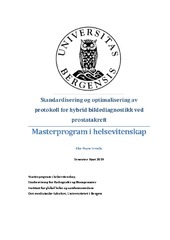Standardisering og optimalisering av protokoll for hybrid bildediagnostikk ved prostatakreft
Abstract
Sammendrag Bakgrunnen for studien var oppstarten av en ny undersøkelse ved ST Olavs hospital for pasienter diagnostisert med prostatakreft. Hensikten er å fremme et forslag til standardisert og optimalisert protokoll for Positron emisjon tomografi, PET, kombinert med computertomografi (CT) og/ eller magnetisk resonans (MR) for denne pasientgruppen. Problemstilling: Vurdere valg av rekonstruksjonsmatrise, valg av PET/CT eller PET/MR ved ulik Body Mass Index, og optimal tid mellom injeksjon og PET-opptak. Metode: 30 pasienter fikk injisert en dose med 18F-PSMA-1007 før PET/CT og PET/MR ble utført samme dag. SUVmax fra utvalgte lesjoner ble målt for vurdering av rekonstruksjonsmatrise, og for optimalisering av tid mellom injeksjon og PET-opptak. En subjektiv visuell vurdering av lesjonene i begge matrisene ble utført. Standardavvik og mean counts målt i lever før beregning av koeffisient av varians, COV til vurdering av modalitet ved ulik BMI. For optimalisering av tid mellom injeksjon og PET-opptak ble SUVmax interpolert til fire utvalgte tidspunkt. Resultater: Det er signifikant forskjell i SUVmax på 256 x 256 matrise og 400 x 400 matrise. Subjektiv visuell bedømmelse av PET-bildene viste også forskjell mellom matrisene. Ved BMI<30 var det ingen signifikant forskjell på COV på PET/CT og PET/MR. I gruppen BMI>30 er signifikant forskjell. Basert på gjennomsnittlig SUVmax ser det ut til at SUVmax viser en synkende trend mellom 120 og 240 minutter. Konklusjon: Anbefalt rekonstruksjonsmatrise er 400 x 400. Ved BMI <30 kan både PET/CT og PET/MR benyttes, ved BMI>30 anbefales PET/CT. Optimal tid mellom injeksjon og start PET-opptak er mellom 120 og 200 minutter. ABSTRACT The background for the thesis was the initiation of a new study at St Olavs hospital for patients diagnosed with prostate cancer. The aim of the thesis is a proposal standardized and optimized protocol for positron emmsion tomography, PET, combined with computer tomography (CT) and/or magnetic resonans (MRI) for this patient group. Objectives: Assessment of change in reconstruction matrix. Choice of modality at different Body Mass Index, and optimal time between injection and PET-scan. Method: 30 patients were injected with one dose of 18F-PSMA-1007 before PET/CT and PET/MR were performed on the same day. SUVmax from selected lesions was measured for assessment of reconstruction matrix and for optimizing time between injection and PET-scan. A subjective visual assessment of the lesions of both matrixes was also carried out. Standard deviation and mean counts was measured in the liver before calculating coeffisient of varianse (COV) to assess which modality is best for different BMI. For optimizing time between injection and PET-scan, SUVmax was interpolated to four selected timepoints. Results: There is a significant difference between the matrixes. Subjective visual assessment of the attenuated PET scans also showed a difference between the matrixes. At BMI <30 there was no significant difference in COV between PET/CT and PET/MRI. At group BMI > 30 there was a significant difference between COV in PET/CT and PET/MRI. Based on average SUVmax it appears that SUVmax has a decreasing trend between 120 and 240 minutes. Conclusion: based on our results, the following are recommended: reconstruction matrix is 400 x 400. At BMI < 30 both PET/CT and PET/MRI can be used at BMI > 30 is recommended PET/CT. Optimal time between injection and start scan is between 120 and 200 minutes
Publisher
The University of BergenCopyright
Copyright the Author. All rights reservedRelated items
Showing items related by title, author, creator and subject.
-
Assessment of Image Quality of a PET/CT scanner for a Standarized Image situation Using a NEMA Body Phantom. “The impact of Different Image Reconstruction Parameters on Image quality”
Quaye, Michael (Master thesis, 2013-09-01)Radiologists and medical practitioners are working daily with images from integrated Positron Emission Tomography/ Computed Tomography (PET/CT) scanners in order to detect potentially lethal diseases. It is thus very ... -
Supervised injectable heroin treatment and fatal overdose: a system dynamics model to assess the impact of supervised injectable heroin treatment on fatal overdoses in Bergen, Norway
Anastasiadou, Eftychia (Master thesis, 2014-06-10)The city of Bergen, Norway, is troubled by a large number of deaths caused by opioid related overdoses. The number of deaths is also an indication of drug addict suffering, close family worries, drug trade and other criminal ... -
Effect of Combined Low Salinity and Surfactant Injection on Oil Recovery in Aged Bentheimer Sandstones at Different Temperatures
Riisøen, Solveig (Master thesis, 2012-06-01)A moderate increase in crude oil recovery by reduction in salinity of the injection brine has been observed for numerous laboratory core flood experiments. The underlying mechanisms behind increased recovery by low salinity ...
